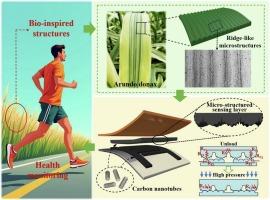Flexible pressure sensor with bioinspired hierarchical ridge-like microstructures with high sensitivity and wide detection range based on MWCNT composites
IF 8.1
2区 材料科学
Q1 ENGINEERING, MANUFACTURING
Composites Part A: Applied Science and Manufacturing
Pub Date : 2025-09-18
DOI:10.1016/j.compositesa.2025.109309
引用次数: 0
Abstract
Flexible pressure sensors have attracted significant attentions for their promising applications in wearable electronics and healthcare monitoring systems. However, the simultaneous realization of high sensitivity and wide detection range remains highly challenging. To this aim, a flexible piezoresistive pressure sensor with bioinspired hierarchical ridge-like microstructures (BHRM) was proposed to achieve high sensitivity and wide detection range simultaneously. The sensing layer was fabricated by a bionic template method using Arundo donax leaves as the template in a fast and cost-effective way, in which composites of multi-walled carbon nanotubes (MWCNT) and polydimethylsiloxane (PDMS) were synthesized with excellent flexibility and piezoresistive properties. MWCNT/silicone elastomer electrodes were prepared by a direct ink writing (DIW) method. The hierarchical ridge-like microstructures with parallel primary ridges and secondary ridges contributed to enhance contact area and deformation capacity, and maintain continuous contact between the sensing layer and electrodes. The sensor showed a high sensitivity of 3.08 kPa−1 within 0.1–10 kPa and a wide linear measurement range of 0.1–200 kPa. It also presented high stability of over 5000 cycles, short response/relaxation times of 35 ms/40 ms, respectively, and low hysteresis error of 4.7 %. The sensor demonstrated capabilities in real-time movement detection, speech recognition, and pulse and heartbeat monitoring.

基于纳米碳纳米管复合材料的生物启发层次脊状微结构柔性压力传感器,具有高灵敏度和宽检测范围
柔性压力传感器因其在可穿戴电子产品和医疗监测系统中的应用前景而受到广泛关注。然而,同时实现高灵敏度和大探测范围仍然是一个很大的挑战。为此,提出了一种具有生物启发层次脊状微结构(BHRM)的柔性压阻压力传感器,该传感器可同时实现高灵敏度和宽检测范围。采用仿生模板法制备了多壁碳纳米管(MWCNT)和聚二甲基硅氧烷(PDMS)复合材料,制备了具有优异柔韧性和压阻性能的传感层。采用直接墨水写入法(DIW)制备了MWCNT/硅弹性体电极。平行主脊和次脊的层次化脊状微结构有助于增加接触面积和变形能力,并保持传感层与电极之间的连续接触。该传感器在0.1 ~ 10kpa范围内具有3.08 kPa−1的高灵敏度和0.1 ~ 200kpa的宽线性测量范围。该方法具有5000次以上的高稳定性,响应/弛豫时间分别为35 ms/40 ms,迟滞误差低至4.7%。该传感器具有实时运动检测、语音识别、脉搏和心跳监测等功能。
本文章由计算机程序翻译,如有差异,请以英文原文为准。
求助全文
约1分钟内获得全文
求助全文
来源期刊

Composites Part A: Applied Science and Manufacturing
工程技术-材料科学:复合
CiteScore
15.20
自引率
5.70%
发文量
492
审稿时长
30 days
期刊介绍:
Composites Part A: Applied Science and Manufacturing is a comprehensive journal that publishes original research papers, review articles, case studies, short communications, and letters covering various aspects of composite materials science and technology. This includes fibrous and particulate reinforcements in polymeric, metallic, and ceramic matrices, as well as 'natural' composites like wood and biological materials. The journal addresses topics such as properties, design, and manufacture of reinforcing fibers and particles, novel architectures and concepts, multifunctional composites, advancements in fabrication and processing, manufacturing science, process modeling, experimental mechanics, microstructural characterization, interfaces, prediction and measurement of mechanical, physical, and chemical behavior, and performance in service. Additionally, articles on economic and commercial aspects, design, and case studies are welcomed. All submissions undergo rigorous peer review to ensure they contribute significantly and innovatively, maintaining high standards for content and presentation. The editorial team aims to expedite the review process for prompt publication.
 求助内容:
求助内容: 应助结果提醒方式:
应助结果提醒方式:


